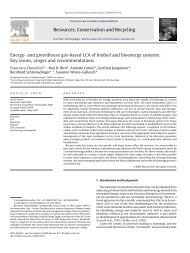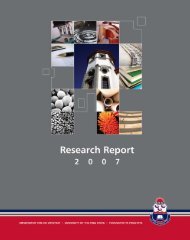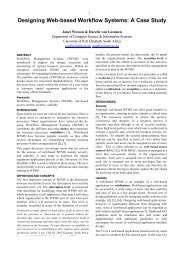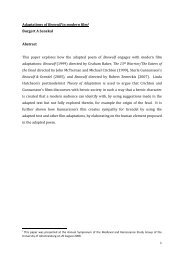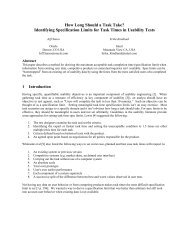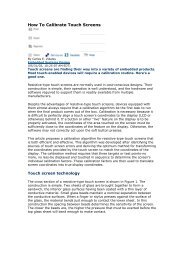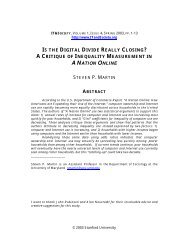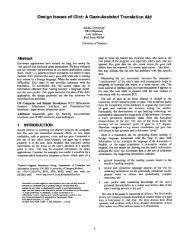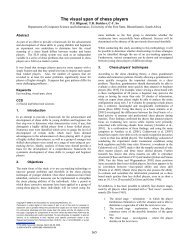534 A. Durndell, Z. Haag / <strong>Computer</strong>s in Human Behavior 18 (2002) 521–535Bandura, A. (1997). The exercise of control. New York: W. H. Freeman.Beckers, J., & Schmidt, H. (2001). The structure of <strong>computer</strong> <strong>anxiety</strong>: a six factor model. <strong>Computer</strong>s inHuman Behavior, 17(1), 35–49.Brosnan, M. (1998). Technophobia. London: Routledge.Brosnan, M., & Lee, W. (1998). A cross cultural comparison of gender differences in <strong>computer</strong> <strong>attitudes</strong>and <strong>anxiety</strong>: <strong>the</strong> UK and Hong Kong. <strong>Computer</strong>s in Human Behavior, 14(4), 559–577.Buckley, M. (1989). Women and ideology in <strong>the</strong> Soviet Union. Hemel Hempstead, England: HarvesterWheatsheaf.Chua, S., Chen, D., & Wong, P. (1999). <strong>Computer</strong> <strong>anxiety</strong> and its correlates: a meta analysis. <strong>Computer</strong>sin Human Behavior, 15(5), 609–623.Coffin, R., & Mackintyre, P. (2000). Cognitive, motivation and affective processes associated with <strong>computer</strong>related performance: a path analysis. <strong>Computer</strong>s in Human Behavior, 16(2), 199–222.Colley, A., Gale, M., & Harris, T. (1994). Effects of gender role identity and experience on <strong>computer</strong>attitude components. Journal of Educational Computing Research, 10(2), 129–137.Durndell, A. (1991). Paradox and practice: gender in computing and engineering in eastern Europe. InG. Lovegrove, & B. Segal (Eds.), Women into computing: selected papers 1988–1990 (pp. 392–400).London: Springer Verlag.Durndell, A., Cameron, C., Knox, A., Stocks, R., & Haag, Z. (1997). Gender and computing: west andeast Europe. <strong>Computer</strong>s in Human Behavior, 13(2), 269–280.Durndell, A., Haag, Z., & Laithwaite, H. (2000). <strong>Computer</strong> <strong>self</strong> <strong>efficacy</strong> and gender: a cross cultural studyof Scotland and Romania. Personality and Individual Differences, 28, 1037–1044.Durndell, A., & Thomson, K. (1997). Gender and computing: a decade of change? <strong>Computer</strong>s and Education,28(1), 1–9.Durndell, A., Uzunova, F., Asenova, D., Asenov, A., & Thomson, K. (1998). Gender neutral engineering:an impossible dream?—<strong>the</strong> case of east Europe. International Journal of Science Education, 20(7), 783–793.Farenga, S., & Joyce, B. (1999). Intentions of young students to enrol in science courses in <strong>the</strong> future: anexamination of gender differences. Science Education, 83(1), 55–75.Gackenbach, J. (Ed.). (1998). Psychology and <strong>the</strong> Internet: intrapersonal, interpersonal and transpersonalimplications. New York: Academic Press.Griffiths, M. (1999). Internet addiction. The Psychologist, 12(5), 246–250.Grundy, F. (1996). Women and <strong>computer</strong>s. Exeter, England: Intellect Books.Heinssen, R. K., Glass, C. R., & Knight, L. A. (1987). Assessing <strong>computer</strong> <strong>anxiety</strong>: development andvalidation of <strong>the</strong> <strong>computer</strong> <strong>anxiety</strong> rating scale. <strong>Computer</strong>s in Human Behavior, 3, 49–59.HESA (Higher Education Statistics Agency) (2000). Higher education statistics for <strong>the</strong> UK, 1998/9. London:HESA.Holdstock, L. (1989). The ratio of male to female undergraduates. In J. Radford (Ed.), Gender and choicein education and occupation (pp. 59–83). London: Routledge.Kraut, R., Patterson, M., Lundmark, V., Kiesler, S., Mukopadhyay, T., & Scherlis, W. (1989). Internetparadox: a social technology that reduces social involvement and psychological well-being? AmericanPsychologist, 53(9), 1017–1031.Levine, T., & Donitsa-Schmidt, S. (1998). <strong>Computer</strong> use, confidence, <strong>attitudes</strong> and knowledge: a causalanalysis. <strong>Computer</strong>s in Human Behavior, 14(1), 125–146.Maurer, M. (1994). <strong>Computer</strong> <strong>anxiety</strong> correlates and what <strong>the</strong>y tell us: a literature review. <strong>Computer</strong>s inHuman Behavior, 10(3), 369–376.McIlroy, D., Bunting, B., Tierney, K., & Gordon, M. (2001). The relation of gender and backgroundexperience to <strong>self</strong> reported computing <strong>anxiety</strong> and cognitions. <strong>Computer</strong>s in Human Behavior, 17(1),21–33.Miller, J., & Durndell, A. (2001). Internet use, <strong>computer</strong> <strong>anxiety</strong> and <strong>attitudes</strong> <strong>towards</strong> <strong>the</strong> Internet: acomparison of <strong>the</strong> USA and Scotland. Proceedings of <strong>the</strong> British Psychological Society, 9(2), 108.Morahan-Martin, J. (1998). Males, females and <strong>the</strong> Internet. In J. Gackenbach (Ed.), Psychology and <strong>the</strong>Internet: intrapersonal, interpersonal and transpersonal implications (pp. 169–184). New York: AcademicPress.
A. Durndell, Z. Haag / <strong>Computer</strong>s in Human Behavior 18 (2002) 521–535 535Morahan-Martin, J., & Schumacher, P. (2000). Incidence and correlates of pathological Internet useamongst college students. <strong>Computer</strong>s in Human Behavior, 16(1), 13–29.Murphy, C., Coover, D., & Owen, S. (1989). Development and validation of <strong>the</strong> <strong>computer</strong> <strong>self</strong>-<strong>efficacy</strong>scale. Educational and Psychological Measurement, 49, 893–899.Nickel, H. (1993). Women in <strong>the</strong> GDR and in <strong>the</strong> new Federal states. In N. Funk, & M. Mueller (Eds.),Gender politics and post communism (pp. 138–150). London: Routledge.Nickell, G. S., & Pinto, J. N. (1986). The <strong>Computer</strong> Attitude Scale. <strong>Computer</strong>s in Human Behavior, 2, 301–306.Odell, P., Korgen, K., Schumacher, P., & Delucchi, M. (2000). Internet use among female and male collegestudents. CyberPsychology and Behavior, 3(5), 855–862.Pohl, M. (1997). The Internet: a feminine technology? In R. Lander, & A. Adam (Eds.), Women in Computing(pp. 190–197). Exeter, England: Intellect Books.Reinen, I., & Plomp, T. (1997). Information technology and gender equality: a contradiction in terminis?<strong>Computer</strong>s and Education, 28(2), 65–78.Roger, A., & Duffield, J. (2000). Factors underlying persistent gendered option choices in school scienceand technology in Scotland. Gender and Education, 12(3), 367–384.Schumacher, P., & Morahan-Martin, J. (2001). Gender, Internet and <strong>computer</strong> <strong>attitudes</strong> and experiences.<strong>Computer</strong>s in Human Behavior, 17(1), 95–110.Sherman, R., End, C., Kraan, E., Cole, A., Campbell, J., Birchmeier, Z., & Klausner, J. (2000). TheInternet gender gap among college students: forgotten but not gone? Cyberpsychology and Behavior,3(5), 885–894.Sussman, N., & Tyson, D. (2000). Sex and power: gender differences in <strong>computer</strong> mediated interactions.<strong>Computer</strong>s in Human Behavior, 16(4), 381–394.Todman, J. (2000). Gender differences in <strong>computer</strong> <strong>anxiety</strong> among university entrants since 1992. <strong>Computer</strong>sand Education, 34, 27–35.Torkzadeh, G., & Koufteros, X. (1994). Factoral validity of a <strong>computer</strong> <strong>self</strong> <strong>efficacy</strong> scale and <strong>the</strong> impactof <strong>computer</strong> training. Educational and Psychological Measurement, 54(3), 813–921.Turkle, S. (1995). Life on <strong>the</strong> screen: identity in <strong>the</strong> age of <strong>the</strong> Internet. New York: Simon & Schuster.Weiser, E. (2000). Gender differences in Internet use patterns and Internet application preferences: a twosample comparison. CyberPsychology and Behavior, 3(2), 167–178.Whitely, B. (1997). Gender differences in <strong>computer</strong> related <strong>attitudes</strong> and behaviour: a meta analysis.<strong>Computer</strong>s in Human Behavior, 13(1), 1–22.Wright, R. (1997). Women in computing: a cross national analysis. In R. Lander, & A. Adam (Eds.),Women in computing (pp. 72–83). Exeter, England: Intellect Books.



